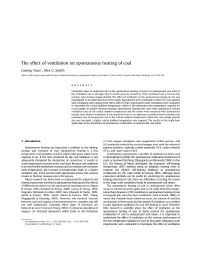Mining Publication: The Effect of Ventilation on Spontaneous Heating of Coal
Original creation date: January 2011
Ventilation plays an important role in the spontaneous heating of coal in an underground coal mine. If the ventilation rate is too high, heat is carried away by convection. If the ventilation rate is too low, the reaction rate becomes oxygen-limited. The effect of ventilation on the spontaneous heating of coal was investigated in an isothermal oven in this study. Experiments were conducted on three U.S. coal samples with ventilation rates ranging from 100 to 500 cm3/min. Experiments under ventilation were conducted to determine the critical ambient temperature, which is the minimum oven temperature required for a coal sample to achieve thermal runaway. Spontaneous heating tests were then conducted at various ventilation rates at the critical ambient temperature and the results were compared with spontaneous heating tests without ventilation. It was found that there is an optimum ventilation flow to produce the maximum rate of temperature rise at the critical ambient temperature. When the coal sample particle size was increased, a higher critical ambient temperature was required. The results in this study have application in the prevention of spontaneous combustion in underground coal mines
Authors: L Yuan, AC Smith
See Also
- CFD Modeling of Spontaneous Heating in a Large-Scale Coal Chamber
- Effects of Ventilation and Gob Characteristics on Spontaneous Heating in Longwall Gob Areas
- Methane Control for Underground Coal Mines
- Refuge Alternatives in Underground Coal Mines
- Simulation of Spontaneous Heating in Longwall Gob Area with a Bleederless Ventilation System
- SPONCOM - A Computer Program for the Prediction of the Spontaneous Combustion Potential of an Underground Coal Mine
- Spontaneous Combustion
- Technology News 441 - SPONCOM - An Expert System to Predict Spontaneous Combustion Potential of a Coal Mining Operation
- Technology News 545 - NIOSH Updates Spontaneous Combustion Assessment Software
- Wireless Mesh Mine Communication System
- Content source: National Institute for Occupational Safety and Health, Mining Program


 ShareCompartir
ShareCompartir
